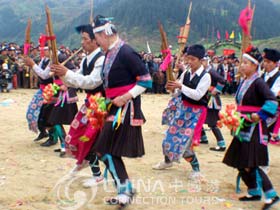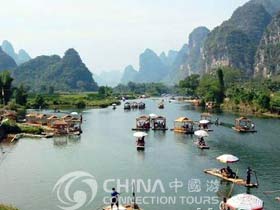Guangxi is known for its picturesque mountains and rivers. The Guangxi Basin is high on four sides and low in the middle topographically. It is ringed with mountains, most of which are 1,000-1,500 meters above sea level. The central part of the basin contains vast areas of flatland with fertile soil and is the major grain and sugar-cane grower of the region. The southern half contains wide areas of hilly land interspersed with orchards and rice fields. The Guilin - Yangshuo area has karst topography where erosion of the limestone has given shape to numerous exotic pinnacles and spires, bizarre sink-holes and caverns, picturesque hills and subterranean streams.
There are a number of large rivers in the province. The Zhujiang river system drains 85 per cent of Guangxi’s total area. Its trunk streams consist of the Nanpan, Hongshui, Qianjiang and Xunjiang and its principal branch streams are the Yujiang, Liujiang and Guijiang
Guangxi sits astride the Tropic of Cancer and has a sub-tropical climate with long summers and warm winters, plentiful rainfall, and frequent rainstorms and typhoons in summer and autumn. It has an average annual temperature of 17-23ºC (64-70F), with an average annual precipitation of 1,250-2,700 mm.
 The traditional customs that have been maintained by Guangxi's many ethnic communities are a magnet for both Chinese and foreign tourists. All minority groups maintain their own festivals and customs. They often wear their native garb, brightly colorful costumes made of hand-woven cloth, embroidered with exquisite designs. The women favor silver rings, necklaces, bracelets, hairpins and buttons. Men and women alike are fond of singing and dancing. Many festivals and sacrificial rites are held throughout the year, which unfailingly impress visitors with their hilarity or solemnity. A visitor to Guangxi, can’t get away with merely sitting back and watching a few traditional ethnic performances, the local people, well known for their generosity, simplicity, hospitality and honesty, are more than likely to invite them to join in the fun. If this sounds appealing you may want to sign up for the Folk Customs Tour, which highlights the music of the Zhuang nationality, the dance of the Yao nationality, the festivals of the Miao nationality and the buildings and bridges of the Dong nationality.
The traditional customs that have been maintained by Guangxi's many ethnic communities are a magnet for both Chinese and foreign tourists. All minority groups maintain their own festivals and customs. They often wear their native garb, brightly colorful costumes made of hand-woven cloth, embroidered with exquisite designs. The women favor silver rings, necklaces, bracelets, hairpins and buttons. Men and women alike are fond of singing and dancing. Many festivals and sacrificial rites are held throughout the year, which unfailingly impress visitors with their hilarity or solemnity. A visitor to Guangxi, can’t get away with merely sitting back and watching a few traditional ethnic performances, the local people, well known for their generosity, simplicity, hospitality and honesty, are more than likely to invite them to join in the fun. If this sounds appealing you may want to sign up for the Folk Customs Tour, which highlights the music of the Zhuang nationality, the dance of the Yao nationality, the festivals of the Miao nationality and the buildings and bridges of the Dong nationality.
At the end of 2005, the total population of Guangxi was 49.25 million. The largest ethnic groups are the Zhuang, Han, Yao, Miao, Dong, Mulam, Maonan, Hui, Jing, Yi, Shui and Gelao. There are 25 smaller ones. The Zhuang is the largest ethnic minority group in the region, with a population of 15.38 million.
Guangxi is an ideal place for vacationers. Its charming waters and mountains, subtropical seaside scenery in Beibu Bay, ancient ethnic customs and the Sino-Vietnamese border towns, two of which are Pingxiang and Dongxing, offer a unique traveling experience. The karst limestone topography has created some of the world's most stunning scenery--jagged  green mountains beside clear blue waters. The Lijiang River, Reed Flute Cave , Seven Star Park, Folded Brocade Hill (Diecai Shan), Wind and Rain Bridge and the Mapang Drum Tower of the Dong ethnic minority are the most popular tourist sites, but the province abounds in mountains, hot springs, rivers and beaches. Guilin and Yangshuo are two of the most exceptionally beautiful areas in China. Guilin is one of the four most visited places in China. It is famous throughout the world for its green hills, clear waters, unique caves and beautiful rocks. Beihai's Silver Beach is a playground of white sand, calm seas, clear water and gentle waves.
green mountains beside clear blue waters. The Lijiang River, Reed Flute Cave , Seven Star Park, Folded Brocade Hill (Diecai Shan), Wind and Rain Bridge and the Mapang Drum Tower of the Dong ethnic minority are the most popular tourist sites, but the province abounds in mountains, hot springs, rivers and beaches. Guilin and Yangshuo are two of the most exceptionally beautiful areas in China. Guilin is one of the four most visited places in China. It is famous throughout the world for its green hills, clear waters, unique caves and beautiful rocks. Beihai's Silver Beach is a playground of white sand, calm seas, clear water and gentle waves.

